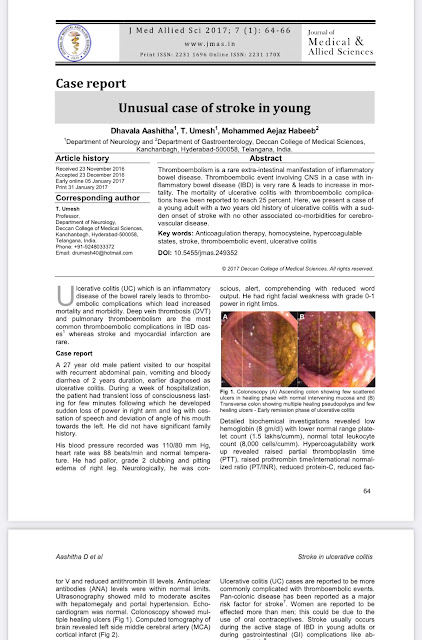Covid 19 study in a rural health service
I've conducted a retrospective study on covid 19 patients evaluating their clinical course and risk factors for mortality. The following is the abstract of the paper I'm currently working on.
Abstract:
Introduction:
In December, 2019, Wuhan city, China, became the centre of an outbreak for pneumonia of unknown cause. By January, 2020, Chinese scientists had isolated a novel coronavirus, severe acute respiratory syndrome coronavirus, from these patients with virus-infected pneumonia, which was later designated coronavirus disease 2019 (COVID-19) in February, 2020, by WHO.
In this study we discuss the various clinical presentations and the risk factors for mortality observed in covid 19 patients.
Materials and methods:
This is a retrospective study conducted at Kamineni Insitute of Medical Scineces, Narketpally including 34 inpatients who were tested positive by SARS COV2 RNA.
Results:
Among 34 patients , 65% were men and 35% were women. 9 patients died during hospitalization and 25 patients were discharged. The most common comorbidity found in these patients were Hypertension ( 35%), Diabetes Mellitus (32%), followed by chronic kidney disease (8%), Hypothyroid (5%). The most common risk observed among patients who died were older age and a high D dimer and modified SOFA score value.
Discussion:
We observed that the most common risk factor among our patients was Hypertension followed by Diabetes Mellitus with 9% being diagnosed with denovo Diabetes Mellitus type 2 after presentation.
The mortality rates were high among the elderly patients and it was also noted that the modified SOFA score and d Dimers were high among these patients.
Older age has been reported as an important independent predictor of mortality in SARS and MERS.
The age-dependent defects in T-cell and B-cell function and the excess production of type 2 cytokines could lead to a deficiency in control of viral replication and more prolonged proinflammatory responses, potentially leading to poor outcome.
SOFA score is a good diagnostic marker for sepsis and septic shock, and reflects the state and degree of multi-organ dysfunction
High levels of d-dimer have a reported association with 28-day mortality in patients with infection or sepsis identified in the emergency department.
Conclusion:
In this study we throw some light on the clinical presentation and the risk factors for mortality observed in covid 19 patients which would help us anticipate the patient's prognosis.
References:
1.The immunopathogenesis of sepsis in elderly patients.
Clin Infect Dis. 2005; 41: S504-S512
2. Outcomes and prognostic factors in 267 patients with severe acute respiratory syndrome in Hong Kong.
Ann Intern Med. 2003; 139: 715-723
3. Serial evaluation of the SOFA score to predict outcome in critically ill patients.
JAMA. 2001; 286: 1754-1758
4. The Third International Consensus Definitions for Sepsis and Septic Shock (Sepsis-3).
JAMA. 2016; 315: 801-810
5. D-dimer is a significant prognostic factor in patients with suspected infection and sepsis.
Am J Emerg Med. 2012; 30: 1991-1999



Comments
Post a Comment